Ever thought a massage might leave you feeling like you’ve just pressed reset on your body? If you’ve only experienced typical oil-based massages, Thai massage for men might surprise you. Imagine an expert walking, stretching, and pulling your limbs (gently, don’t worry)—all while you’re fully clothed. Thai massage flips the script on what most people expect from a spa day, combining pressure, movement, and centuries of wisdom. This isn’t just another relaxing treatment. It’s sometimes called "lazy yoga"—and yeah, it’s way more engaging than just lying on a table. Let’s break down why guys are booking sessions, what happens in a real Thai massage, and how it could become one of your favorite ways to recharge.
What's a Thai Massage for Men? Your Comprehensive Guide
Thai massage for men is a traditional wellness practice that blends yoga-like stretches, acupressure, and mindful movement. Unlike other massages, it doesn’t require you to undress or get covered in oil. Instead, you wear comfortable clothing and experience rhythmic pressing, stretching, and rocking that helps relieve tension and energize the body. The purpose? Restore balance, improve flexibility, and leave you with a deep sense of calm. Misconceptions pop up all the time—especially that Thai massage is only about deep pressure or, worse, associated with awkward situations. Let’s set the record straight: traditional Thai massage is a respected healing practice in Thailand, rooted in Buddhist traditions. Today, men of all ages seek it out for relaxation, pain relief, and wellness. You'll find answers here about its origins, techniques, the science-backed (and practical) benefits, and some pro tips to get the most out of your first session. Curious how it compares to Swedish or deep tissue massage? Wondering if it’s truly for everyone? We’ll cover that too.
Understanding the Basics of Thai Massage for Men
Origins and History
Thai massage dates back more than 2,000 years, with roots in Ayurvedic medicine and Buddhist teachings. Legend says its founder was the physician to the Buddha himself, Jivaka Kumar Bhaccha. In Thailand, this practice is called "Nuad Boran," meaning “ancient massage.” Over centuries, monks at temples (or "wats") preserved these techniques, passing them down through generations. Thai massage isn’t just about relaxation—it’s about health, longevity, and spiritual balance. The focus on energy lines (sen) and mindful touch comes straight from ancient healing wisdom. Even today, if you travel to Chiang Mai or Bangkok, you’ll notice massage schools attached to temples, teaching students a blend of science and art. While modernization has adjusted some aspects, the basics remain unchanged: movement, pressure, and connection.
Core Principles or Components
At the heart of Thai massage are three things: acupressure, assisted stretching, and rhythmic rocking. Practitioners use their hands, thumbs, elbows, knees—sometimes even feet—to target pressure points and help your body release tension. Unlike other styles, Thai massage follows “sen” lines, which are believed to carry life energy through the body. The session is interactive, with the practitioner guiding you through various stretches similar to yoga poses, but you don't need any flexibility or athletic skill. The idea is to stimulate circulation, encourage natural healing, and foster a sense of total relaxation. Expect gentle pulling, twisting, and deep breathing—it’s as much about mindfulness as muscle.
How It Differs from Related Practices
It’s easy to confuse Thai massage with deep tissue or Swedish massage, but the experience is night and day. Swedish massage focuses on long, gliding strokes with oil while you’re undressed under a sheet. Deep tissue? That’s all about slow, targeted pressure in specific muscle groups. Thai massage, on the other hand, uses clothing, a futon mat on the floor, pressing and stretching, and a flow that feels almost like a dance. Here’s how these compare:
| Practice | Key Feature | Primary Benefit |
|---|---|---|
| Traditional Thai Massage | Assisted stretching, clothing | Flexibility, energy balance |
| Swedish Massage | Oils, relaxing strokes | Stress relief, relaxation |
| Deep Tissue Massage | Slow, deep pressure | Muscle pain relief |
Who Can Benefit from Thai Massage?
There’s no “ideal” body type for Thai massage—it’s designed for anyone looking to unwind, improve their movement, or tackle pain. Office workers with stiff backs, athletes wanting to stay limber, stressed-out professionals, or anyone seeking more energy can benefit. Not flexible? Don’t worry—the practitioner adjusts stretches to your ability. It’s a go-to for men who don’t want to get covered in oil or undress, making it less awkward for first-timers. Whether you’re recovering from a tough workout or just feeling stiff from your daily commute, there’s something for you here.
Benefits of Thai Massage for Body and Mind
Stress Reduction
Thai massage is famous for melting away stress. Between the slow, deliberate stretches and the focus on breath, it’s kind of like active meditation. The combination helps calm your nervous system, lowering stress hormones and encouraging that “floating on clouds” post-massage feeling. Many clients say that after a good session, both their mind and body feel refreshed—almost like hitting a mental reset button. While it doesn’t fix every worry, making it part of your self-care routine can have a real impact on your mood and mental clarity.
Enhanced Mobility and Flexibility
One of the best perks? You don’t need to be a yoga pro to move better. The practitioner’s guided stretches work through hips, shoulders, neck, and back, helping unlock tight spots you didn’t even know were stiff. If you’ve noticed your range of motion shrinking (hello, desk job), Thai massage can help you move more freely again. Many regulars report easier movement at the gym or just getting up from the couch.
Improved Circulation and Body Awareness
As you’re stretched and pressed, blood and lymph flow improve. This boosts nutrient delivery and helps clear out metabolic waste—a fancy way of saying it helps your body recover and feel lighter. It isn’t just about physical effects, either. You’ll walk out more tuned in to your body, and many people feel more grounded and aware. Some even use Thai massage for post-injury recovery, as long as they get the green light from their healthcare provider.
Practical Applications for Everyday Life
This isn’t just a once-off treat. Regular Thai massage has practical payoffs: better sleep, less muscle soreness, and a calmer approach to daily challenges. It fits nicely into any wellness or fitness routine and can serve as a social or couple bonding activity, too. Here’s a quick overview of key benefits:
| Benefit | Description | Impact |
|---|---|---|
| Relieves stress | Guided relaxation lowers stress hormones | Improved mood, sense of calm |
| Boosts flexibility | Stretching improves range of motion | Better movement, fewer injuries |
| Enhances circulation | Pressure and movement stimulate blood flow | Faster recovery, more energy |
| Sharpens body awareness | Mindful touch increases connection | Greater well-being, focus |
What to Expect When Engaging with Thai Massage for Men
Setting or Context
Forget dim rooms full of burning candles and mood music—Thai massage typically takes place on a thick mat on the floor. You’ll stay fully dressed in loose, comfy clothes (some spas provide cotton pajamas). The space itself feels welcoming, with a touch of Thai décor—think wooden accents and a calm, tidy vibe. There’s a big focus on hygiene, so everything from the mat to the pillows will be spotless. Don’t expect a lot of chit-chat; the mood is usually focused and tranquil, letting you tune in to your body.
Key Processes or Steps
Here’s what happens: You’ll discuss any issues or goals—maybe a tight neck, lower back pain, or just stress. The practitioner starts at your feet, working their way up with palm pressure, thumb rolling, and gentle stretches. The session is like a slow, guided flow, with you breathing deeply and moving as directed. Expect legs pulled gently toward your chest, twists, and rhythmic rocking. The therapist might even use their knees and feet for certain stretches. After the massage, you’ll usually feel lighter, looser, and maybe a little sleepy. Any discomfort during stretching should be mild and fleeting—it should never hurt.
Customization Options
Not everyone wants, or needs, the same intensity. Let your therapist know if you want more or less pressure—or if there are areas to avoid. Some spas offer aromatherapy, gentle or “energy” versions, or massages focused on sports recovery. If you have joint issues, old injuries, or specific requests, speak up before (and during) your session. Good therapists adapt each technique, so the session fits you—not the other way around.
Communication and Preparation
Honest communication is essential. Don’t be shy about mentioning discomfort, health conditions, or recent injuries. Arrive well-hydrated, with light clothing and an open mind. No need to force anything; Thai massage should be a partnership, not a test of flexibility. If you’re shy or anxious, let your therapist walk you through what to expect, so you can relax and enjoy the ride.
How to Practice or Apply Thai Massage for Men
Setting Up for Success
Create a calm space—use a clean futon, mat, or even a yoga mat. Wear clothing you’d wear to lounge at home. Turn off distractions, dim the lights if you feel like it, and keep a water bottle handy. If you’re trying basic moves at home (maybe with a partner), watch some tutorial videos from reputable sources first.
Choosing the Right Resources
Stick with practitioners certified by recognized bodies, like Thai Healing Alliance or similar respected institutions. Check for reviews—good signs are lots of repeat business, clear communication online, and tidy, professional photos of their facility. If you’re learning self-massage techniques, look for books or videos recommended by massage associations.
Step-by-Step Guide
- Briefly warm up with some gentle movements.
- Start at the feet, using rhythmic palms to press and loosen muscles.
- Move up the legs with light kneading or thumb rolling (imagine soft dough).
- Guide the recipient’s leg into a gentle stretch—don’t push beyond comfort.
- Work through the back with pressing and simple twists.
- Always check in—if something hurts, ease off immediately.
For a full-body session, it’s best to leave things to the pros, especially if you’re a beginner.
Tips for Beginners or Couples
Start slow and communicate. Don’t force deep stretches, and remember that every body is different. If you’re learning with a partner, switch roles to understand both perspectives. Avoid areas with sensitive joints if you’re unsure, and focus on breathing together. Go for a short 30-minute session before booking the works—build confidence at your own pace.

Safety and Ethical Considerations
Choosing Qualified Practitioners
Always check credentials and training. A reputable practitioner will have certificates on display, be happy to answer questions, and keep a tidy, professional environment. Industry organizations like AMTA or Thai Healing Alliance can help you verify training.
Safety Practices
Safety comes first. Here’s a helpful reference table to keep in mind:
| Practice | Purpose | Example |
|---|---|---|
| Clean mat/sheets | Reduce infection risk | Fresh linens every client |
| Clear consent | Respect comfort zones | Therapist checks on pressure |
| Gentle pressure | Prevent injury | Adjust based on feedback |
| Health screening | Avoid contraindications | Ask about injuries before start |
Setting Boundaries
Physical boundaries are sacred. Your therapist should never pressure you into stretches, positions, or conversations that feel uncomfortable. If something feels off, speak up right away—professional practitioners want you to have a safe, positive experience. Consent and respect run both ways. Expect clear communication, and don’t hesitate to set limits.
Contraindications or Risks
There are some situations where Thai massage isn’t the best choice. Skip it if you have: acute injuries, serious blood clotting issues, recent surgeries, fractures, or severe osteoporosis. If you have high blood pressure, pregnancy, or chronic conditions, always check with your healthcare team before booking. Bodies are unique—what works wonders for one person might be risky for another, so play it safe.
Enhancing Your Experience with Thai Massage
Adding Complementary Practices
Boost the effects of your Thai massage by pairing it with mindfulness meditation, easy stretching routines, or aromatherapy (if you enjoy scents). Some like to follow up with a short, quiet walk or even a warm bath—not required, but it keeps muscles relaxed and lets mental calm settle in.
Collaborative or Solo Engagement
Going solo with self-massage or booking a pro? Either way works. For couples, learning gentle stretches together can double as quality bonding time. Just remember: don’t get competitive! The focus is on listening and caring, not testing flexibility.
Using Tools or Props
Pillows, yoga bolsters, and lightweight blankets can add comfort, especially for beginners. Some spas use herbal compresses to loosen tight muscles or scented oils for aromatherapy (though classic Thai massage usually skips oil).
Regular Engagement for Benefits
Like any good habit, the gains come with consistency. A session every 2-4 weeks is common, but even occasional massages make a difference. Don’t treat it as a rare splurge; regular practice is the real magic for stress reduction and body balance.
Finding Resources or Experts for Thai Massage for Men
Researching Qualified Experts
Look for licensed therapists, glowing client reviews, and membership in professional organizations. Trusted directories and reputable spa websites (those with transparent policies and a physical location) are your friends. If you can, ask friends or colleagues for referrals—they’re gold.
Online Guides and Communities
Get started with tutorials from well-known wellness sites or official massage organizations. Forums and social groups are also full of tips, stories, and honest feedback (but skip anything that looks sketchy or unprofessional). Some therapists now offer virtual consultations for advice on home practice.
Legal or Cultural Considerations
Thai massage is a respected tradition, but worldwide, people confuse it with non-therapeutic services. Do your research and choose businesses with clear ethical rules, upfront pricing, and professional decorum. In many countries, practitioners need a license—always check the laws in your area before booking.
Resources for Continued Learning
If you catch the bug, there’s a whole world of learning. Quality books break down the theory and moves in detail. Some wellness centers host beginner-friendly workshops or private lessons (perfect if you want to keep it safe and professional). Videos from big wellness organizations or Thai cultural institutes are also a smart way to keep learning—just double check the instructors’ credentials.
FAQ: Common Questions About Thai Massage for Men
Here are some answers to real questions men often ask about Thai massage:
What to expect from a Thai massage for men?
Expect a mix of gentle stretches, deep pressure, and rhythmic movements—fully clothed, on a mat. The practitioner uses hands, elbows, knees, and sometimes feet. Sessions are interactive but deeply relaxing, often leaving you feeling limber, balanced, and mentally recharged.
What happens during a Thai massage session?
The therapist guides you through stretches, presses along energy lines, and helps release tight muscles. They start at your feet, checking in about pressure and comfort, and gradually address the whole body. Clear communication and gradual intensity make it a safe, satisfying process.
How does Thai massage differ from Swedish or deep tissue massage?
Unlike Swedish or deep tissue massage (which use oil and focus mainly on muscle tissue), Thai massage combines acupressure with assisted yoga-like stretching while you’re fully clothed. It’s more dynamic and involves a wider range of movement.
What is the method of Thai massage?
Thai massage relies on pressing, kneading, stretching, and gentle twisting along the body’s energy lines. The practitioner syncs their movements with your breath to help increase relaxation, improve flexibility, and encourage balanced energy flow.
Is Thai massage suitable for beginners?
Absolutely. Thai massage can be adapted for any age, body type, or fitness level. A good therapist will gauge your comfort and experience, using lighter pressure and basic stretches for newcomers. Always discuss your health and goals before the session.
Why Thai Massage for Men is Worth Exploring
A Path to Better Wellness
Thai massage for men isn’t just a trendy treat—it’s a practical, time-tested way to manage stress, move better, and reconnect with your body. No need for yoga skills or special prep. It’s about letting go and letting the experts do their thing, so you can step off the mat refreshed and ready for whatever life throws at you.
Try It Mindfully
The first session is always a little unfamiliar, but trust the process. Work with a certified professional, check in about boundaries, and approach the experience as a mindful adventure. Not every move will feel easy—but honesty and clear communication are your best tools. Tune in, breathe, and give yourself time to adjust.
Share Your Journey
Tried Thai massage for men? Share your experience or tips in the comments below! Want more wellness advice, honest reviews, and real-world tips? Follow my blog for fresh guides about spa wellness and men’s health. Curious? Go ahead—book a session and explore the difference for yourself. Your muscles (and maybe your mood) will thank you!
Some links may be affiliate links, but all recommendations are based on research and quality.


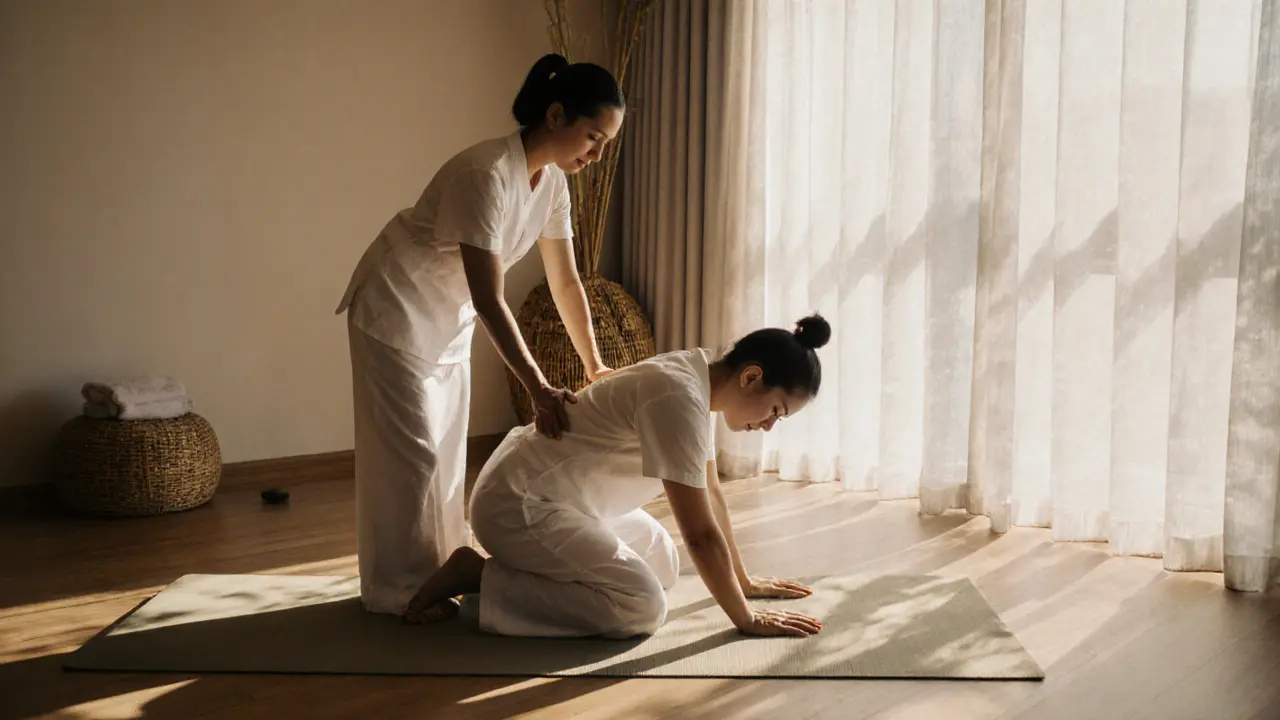
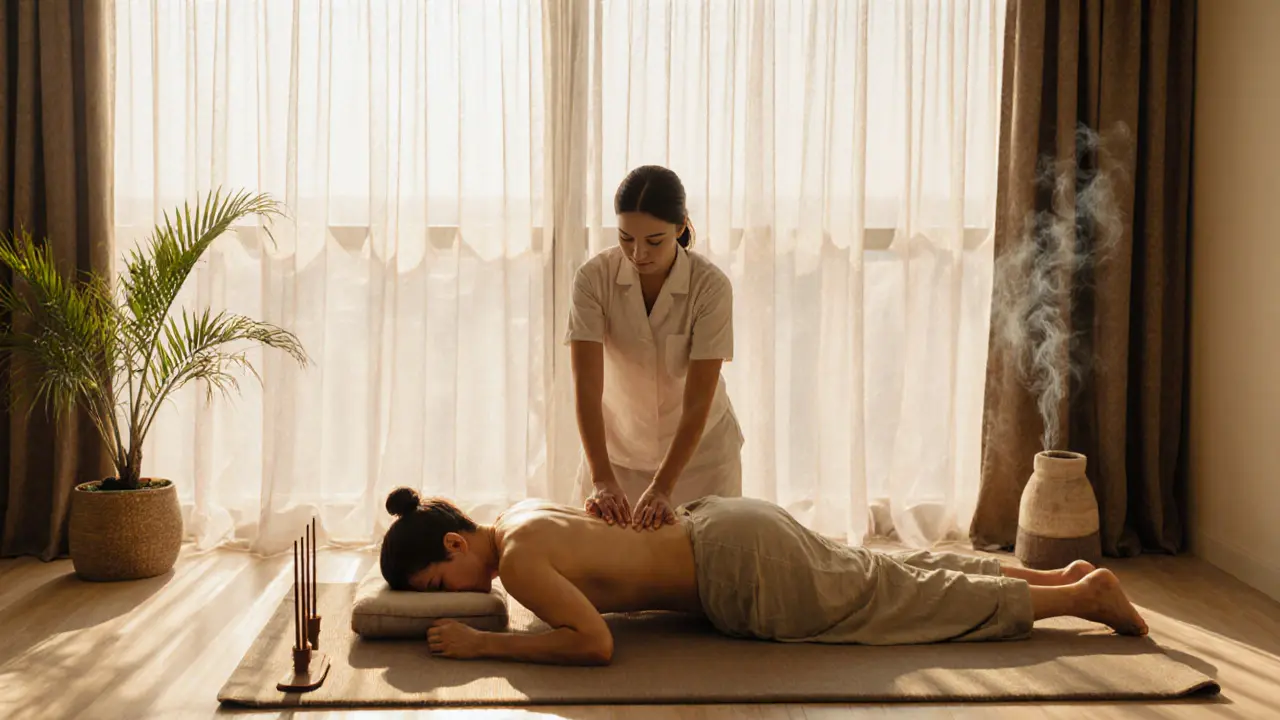
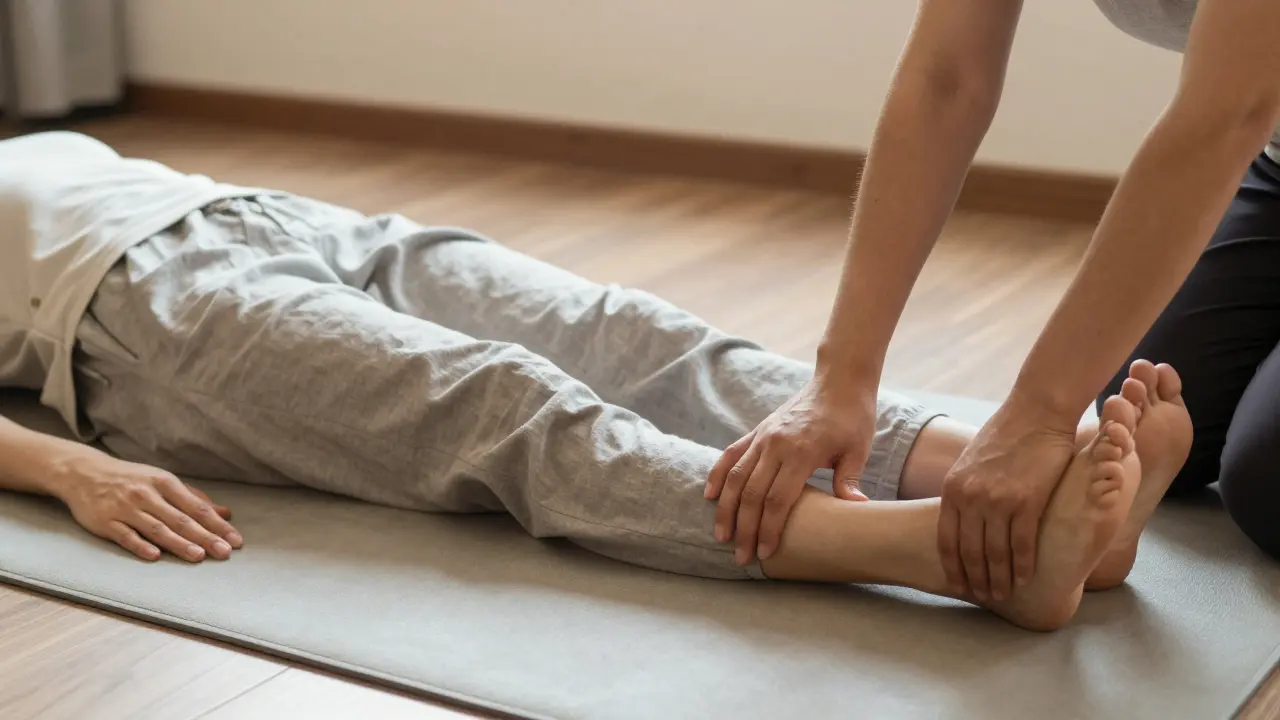
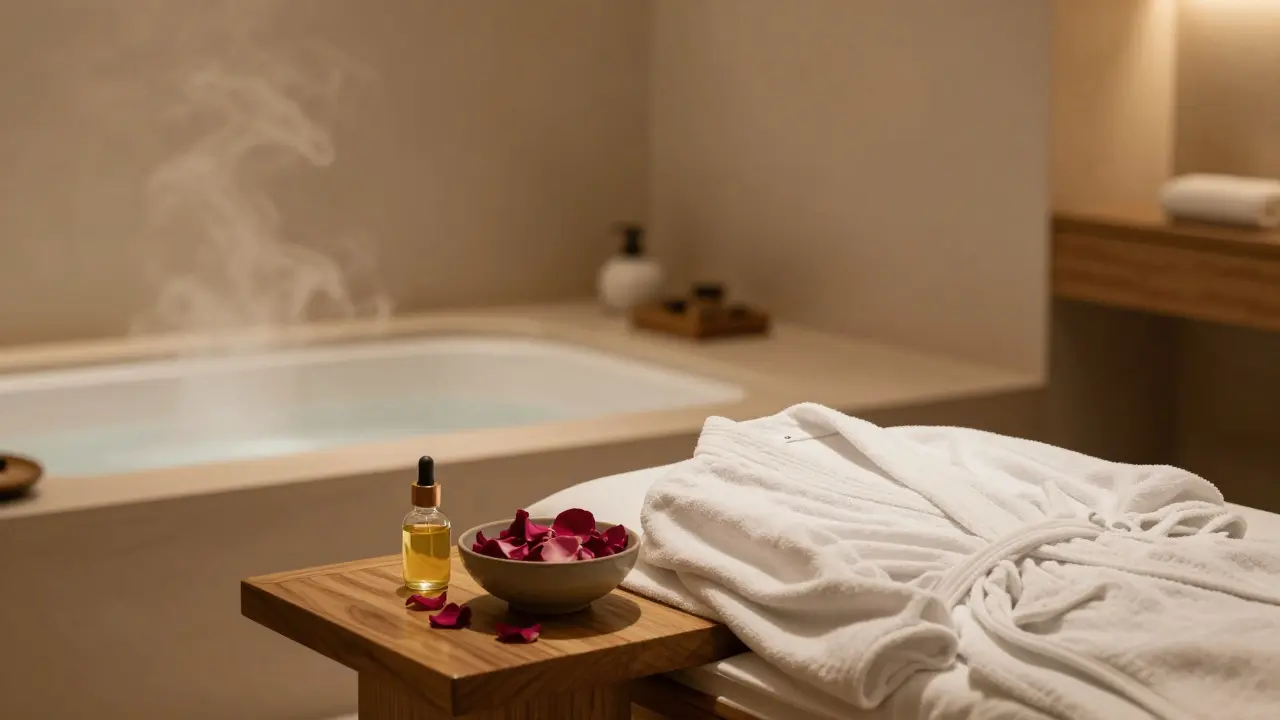
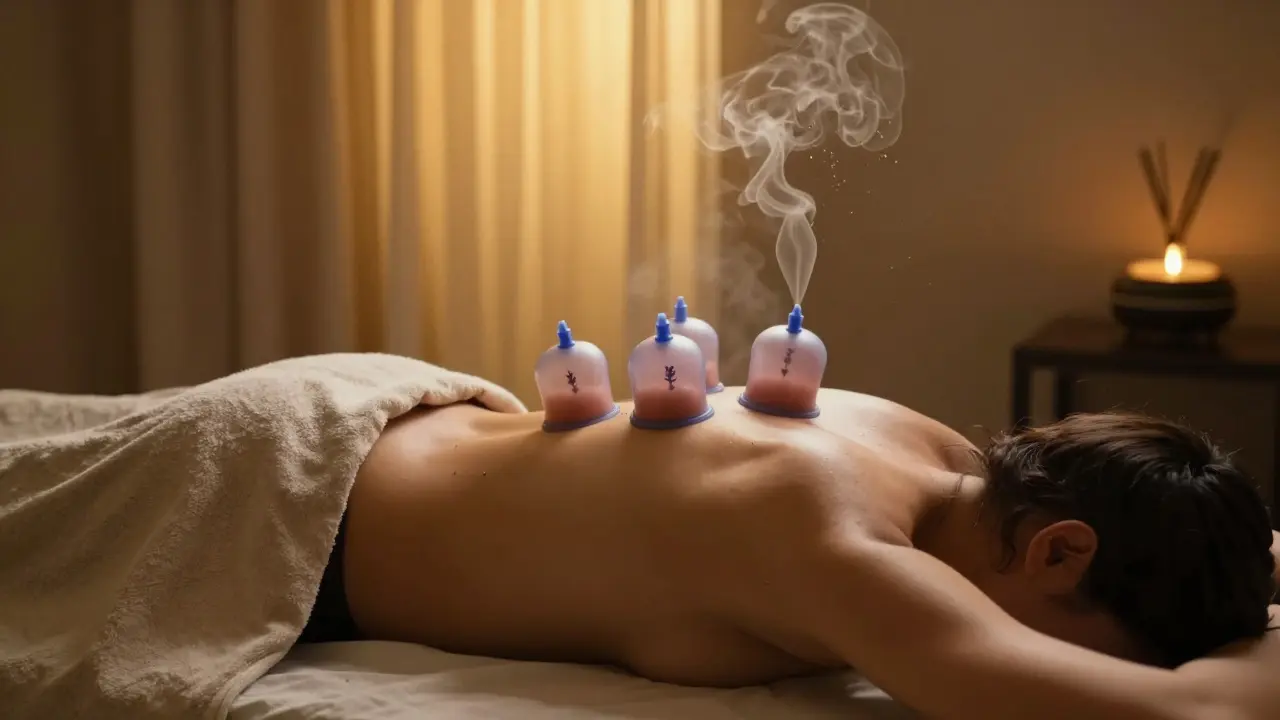
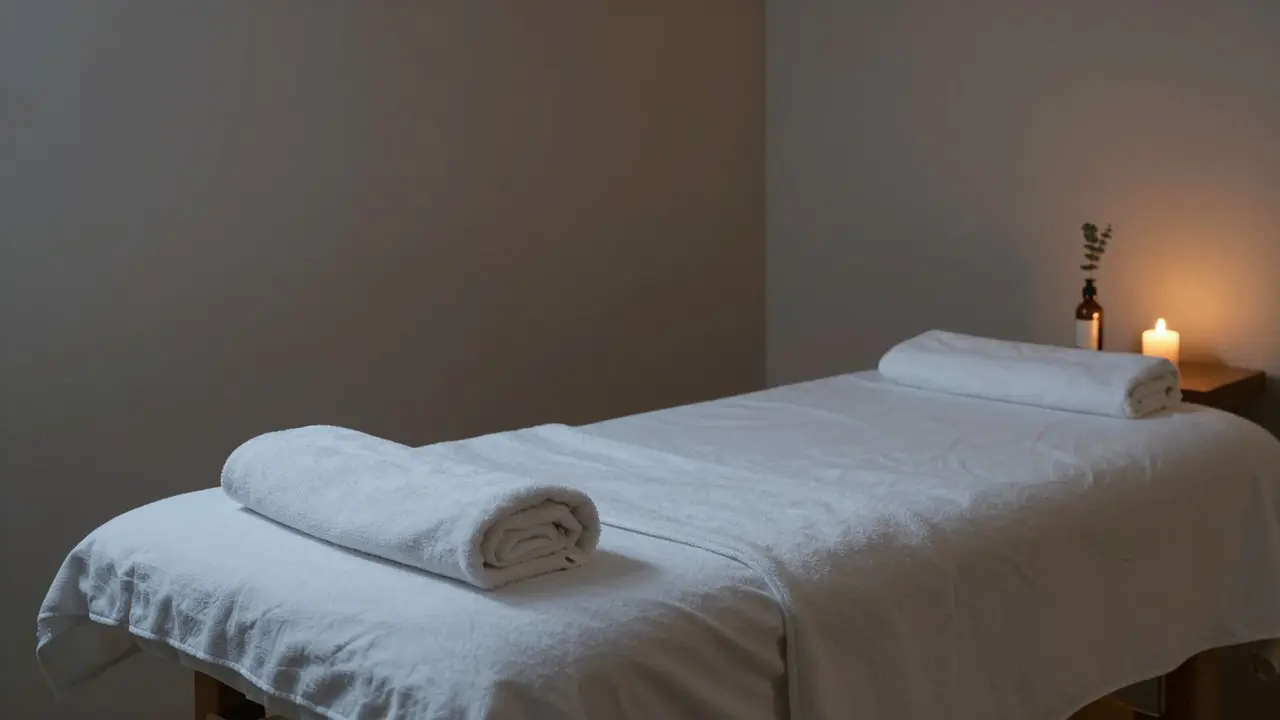
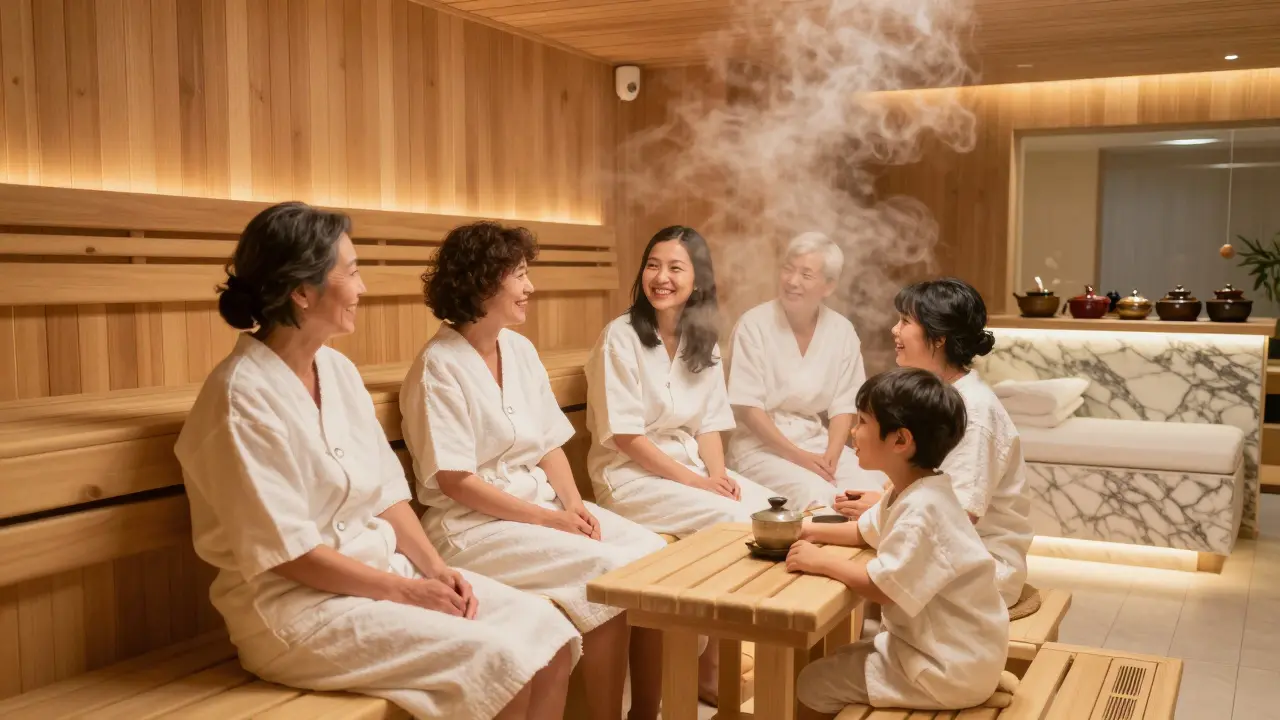
Andre Möller
July 30, 2025 AT 13:45Really solid intro on what Thai massage for men entails. I've tried it a couple of times, and honestly, the blend of stretching and pressure point manipulation feels completely different from your usual massage. It’s like a dynamic therapy that not only relaxes but actually helps with muscle mobility and tension relief.
One thing people don’t always get is its deep cultural roots — Thai massage goes way back and incorporates elements of yoga and traditional medicine. If you’re skeptical, I’d say give it a try, but definitely find a reputable place with trained therapists who respect the tradition.
For men especially, there’s often a misconception that massages are just for relaxation, but Thai massage actively targets energy lines and areas that carry stress. That’s why it feels so rejuvenating afterward.
Would love to see more info on how to prepare for a session — like what to wear or how to communicate your needs with the therapist. Also, post-massage tips would be cool.
Eddie Moss
August 3, 2025 AT 07:46I gotta say, anyone calling 'Thai massage for men' something mysterious clearly hasn't been paying attention. It's just a legit massage style, nothing special gender-wise except maybe how some places cater their vibe. The techniques are all about combining deep pressure and stretching, can be pretty intense if you ain't used to it.
One thing tho: spelling it as 'Masssage' or mixing up names kinda ruins the credibility for those newbies trying to learn. Just call it Thai massage and you'll be fine. No need to overcomplicate this.
Plus, a heads up — always check if the therapist is certified because, it's not just about feeling good, it’s about safety too. Done right, this massage can really help with flexibility and circulation.
Anyone else think it’s kinda hilarious how some folks freak out about the 'men’s massage' label? It’s just a massage, duh.
Natasha Malundu
August 8, 2025 AT 10:00Honestly, the whole hype around "Thai massage for men" feels a bit overrated. Like, massages in general are a luxury but should not be sexualized or marketed specifically to men like this.
This post talks a lot about benefits and history but glosses over the cultural appropriation aspect. Are we really respecting Thai culture or just commodifying it for some voyeuristic male gaze?
And some of the so-called "expert tips"? Feels like generic advice recycled without deeper insight into ethical considerations of the practice.
We should have more serious discussions about how to engage with traditional treatments respectfully and not just skim on the surface for convenience.
But sure, if you want to relax and stretch, there are lots of options that don’t come with problematic commercialism.
Tyler Crimp
August 10, 2025 AT 06:26I appreciate how this guide breaks down the different elements of Thai massage directed for men specifically. It’s informative but remains approachable, which is great for people who might feel intimidated by the concept.
My experience was very positive — the therapist explained everything before we started, which built my trust. The session helped with my lower back pain more than I expected.
I do think it’s important to be open-minded about alternative therapies. There’s real science behind pressure points and muscle stretches, even if some effects are subjective.
Also, this type of massage seems to encourage a more dynamic client-therapist interaction because of the stretches, unlike passive massages where you just lay still.
Would definitely recommend for anyone curious about trying something beyond the typical spa massage.
Madison Horst
August 14, 2025 AT 21:33Wow, Thai massage has always intrigued me but I never understood if there really was a difference when it’s marketed specifically “for men.” This guide sheds some light on that but I’m curious: is it the techniques or the pressure that’s adjusted?
I also wonder how accessible trained Thai massage therapists are outside Thailand. Does anyone know how to spot legit practitioners versus those who just slap the label on?
One thing I’d suggest to any readers is to ask therapists upfront about the specifics and maybe watch some videos to get a feel for the flow before diving in.
Plus, since this focuses a lot on health benefits, a little extra on the potential risks — especially if you have medical conditions — would have been nice here.
Anyway, I’m considering booking a session soon! Let me know if others have tips for first-timers.
Angie Angela
August 16, 2025 AT 08:16Look, if you’re serious about getting a Thai massage, do your homework first and don’t just walk into any random spa. The problem with so many places is the lack of standards and often, the lack of proper hygiene.
Also, it’s annoying how some guides talk about the benefits like they’re guaranteed. This is therapy, not a miracle cure. Approach it responsibly, and know your body.
And please, use correct grammar when asking questions or sharing your experiences online. Clear communication helps everyone.
It’s a nuanced practice. Not every therapist is equal, and not every session will feel the same. Factoring in your own health and preferences is essential before booking.
I’m all for alternative medicine, but coupled with skepticism and caution. That’s the way to go.
julia costa
August 21, 2025 AT 20:13Yeah, I don’t really buy into all the hype. From what I’ve experienced, the pressure can sometimes be way too much, and you’re left wondering if it’s actually helping or just causing bruises.
Call me lazy but I prefer simpler massages that don’t feel like a workout session. If you want a massage, give me something relaxing, not a thing that’s gonna make me sore after.
Also, the whole gendered marketing is a bit weird. Are men supposed to be tougher or what? Just makes everything unnecessarily complicated.
I’d advise folks to be realistic and know what they want before going in expecting miracles.
Patricia Estera Esquejo
August 25, 2025 AT 07:33Here’s my take — Thai massage for men is not just some spa service; it’s a transformative experience if you approach it with the right intention. You’re not only treating your muscles but awakening energies that build resilience both physically and spiritually.
Too many people reduce it to just 'pain relief' or 'relaxation' — which misses the point entirely. It’s an ancient practice that deserves reverence.
The guide could have better emphasized the meditative aspects and the connection between body and mind that Thai massage fosters. That’s where the real magic lives.
So to anyone genuinely interested, I say don’t settle for a quickie session — invest time in understanding the practice and finding a therapist who embodies that tradition.
Clay Hamilton
August 27, 2025 AT 15:06Honestly, I think the fuss over "Thai massage for men" is just marketing fluff designed to reel in a certain demographic who thinks it’s more manly or something.
Massage is massage — the techniques vary but gender-specific treatments are mostly a gimmick. Like, what makes it different beyond the stereotypical macho branding?
The guide's attempt to frame it as this exclusive mystical experience feels a bit overwrought to me. Just get the massage you need and stop pretending it’s some esoteric secret.
That said, the information laid out is helpful if you want a basic understanding — it just seems like it could have been less sensational.
Paul Eric
August 29, 2025 AT 08:46As someone who's been to a few Thai massage sessions, honestly, it’s all pretty straightforward. The main thing you get out of it is a good stretch and pressure on tight spots. Nothing mind-blowing, but still worth it if you’re into that kind of thing.
I don’t see why there has to be such a dramatic explanation or why it’s gendered at all. It’s the same techniques for everyone. Just make sure you’re comfortable with the therapist and speak up if something feels off.
The biggest takeaway for me is that Thai massage is pretty hands-on and requires some openness, which can be awkward at first, but once you get used to it, it works.
In short, treat it like any other bodywork — listen to your body, communicate, and relax.